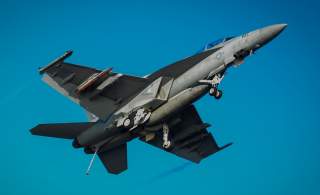Why Landing on a U.S. Aircraft Carrier Is About to Get Much Easier
Thanks to a "magic carpet".
Naval aviators from Carrier Air Wing Eight (CVW-8) are preparing to deploy onboard USS George H.W. Bush (CVN-77) with a revolutionary new type of software that makes landing on a carrier much easier.
Dubbed Magic Carpet—for Maritime Augmented Guidance with Integrated Controls for Carrier Approach and Recovery Precision Enabling Technologies—by the Naval Air Systems Command (NAVAIR), the new system, which aviators call Precision Landing Modes (PLM), drastically reduces workloads in the cockpit during carrier approaches.
“PLM is probably the biggest advancement to carrier aviation since the IFLOLS (improved Fresnel lens optical landing system) was installed,” Lt. Jaime ‘Eeyore’ Moreno, a landing signals officer (LSO) onboard Bush told the Pentagon’s Naval Aviation News service.
Naval aviators flying Boeing F/A-18E/F Super Hornets and EA-18G Growlers during Bush’s pre-deployment work-ups found that the PLM drastically improved landings onboard the giant carrier. Even night carrier traps—which are traditionally considered the single most demanding tasks faced by carrier aviators—are much easier with the PLM installed.
“Flying at night on the first PLM would have been fine, although we started with day flights,” Lt. Zach Pleis, CVW-11 LSO, who had used the system onboard USS Nimitz (CVN-68) in November told Naval Aviation News. “I think it went better than our [Powered Approach Control Augmentation System] players because PLM pilots are developing habit patterns of flying a centered ball vice bumping it up.”
Indeed, the Magic Carpet system has been so successful, that the Navy is deploying it before it has completed development. According to NAVAIR, Magic Carpet was first tested at Naval Air Station Patuxent River, Maryland, and onboard Bush in April 2015. After the demonstration greatly exceeded expectations, NAVAIR made the decision to accelerate the program so that it would become operational before the original 2019 due date.
“All results showed benefits in touchdown dispersion reduction of more than 50 percent when compared to current landing control techniques,” James Denham, a NAVAIR senior aeromechanics engineer told Naval Aviation News.
The current Magic Carpet build does not have all of the redundant features that are envisioned for the final version. However, NAVAIR will use the early feedback from the initial Magic Carpet capability deployments to refine the software for the 2019 version. “Now we have the opportunity to incorporate desired enhancements for the final software release scheduled in fiscal 2019,” Denham said.
Eventually, Magic Carpet will become a standard part of the F/A-18E/F and EA-18G flight control software. For naval aviators, it will mean a safer and easier aircraft to fly. For naval aviation as an enterprise, Magic Carpet will improve its overall effectiveness with much higher boarding rates, reduces tanker requirements and more tactical training time for aviators.
Dave Majumdar is the defense editor for the National Interest. You can follow him on Twitter: @davemajumdar.

